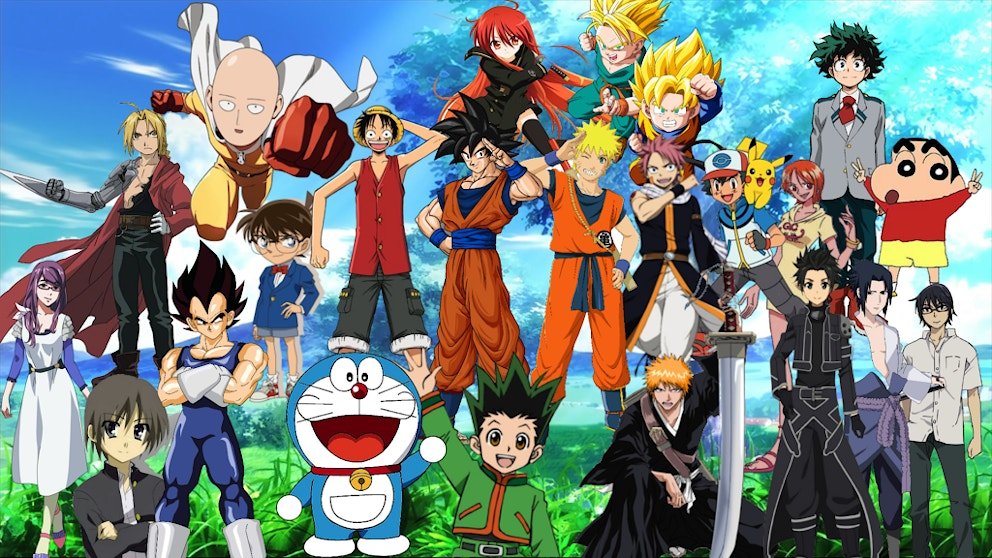Anime is a style of animation that originated in Japan and has become popular worldwide. It features vibrant colors, unique characters, and imaginative worlds. Unlike Western cartoons, anime often explores complex themes and can cater to a wide range of audiences, from children to adults. The history of anime dates back to the early 20th century, with the first recognized anime film being “Namakura Gatana” released in 1917. Over the decades, anime has evolved into a significant cultural phenomenon, influencing global entertainment and media. What sets anime apart from Western cartoons is its art style and storytelling depth, which often includes intricate plotlines and character development. This distinction has helped anime carve out a unique space in the world of animation.
Popular Genres in Anime
Action and Adventure
Anime genres are diverse, with action and adventure being among the most popular. Action anime features dynamic fight scenes, thrilling plotlines, and heroic characters. Series like “Dragon Ball Z” and “Naruto” are prime examples, offering exciting battles and epic journeys. Adventure anime often combines exploration with action, leading characters through fantastical worlds and quests. These genres captivate viewers with their high-energy sequences and compelling stories, making them a favorite among fans who enjoy excitement and suspense.
Romance and Drama
Romance and drama anime focus on emotional storytelling and character relationships. Series like “Your Name” and “Clannad” delve into themes of love, heartbreak, and personal growth. Romance anime explores the ups and downs of relationships, often with a heartwarming or tear-jerking narrative. Drama anime, on the other hand, deals with more serious and sometimes heavy topics, such as family issues or personal struggles. Both genres provide deep emotional experiences and resonate with viewers who appreciate heartfelt and meaningful stories.
Fantasy and Science Fiction
Fantasy and science fiction are genres where imagination knows no bounds. Fantasy anime, like “Sword Art Online” and “Fullmetal Alchemist,” transports viewers to magical realms and introduces mythical creatures. These series often involve epic battles between good and evil and explore themes of heroism and destiny. Science fiction anime, such as “Steins;Gate” and “Cowboy Bebop,” ventures into futuristic and technological worlds, dealing with concepts like time travel, space exploration, and advanced technology. Both genres expand the possibilities of storytelling and offer unique experiences for fans of speculative fiction.
Comedy and Slice of Life
Comedy and slice of life anime offer lighter, often humorous takes on everyday life. Comedy anime, such as “One Punch Man” and “KonoSuba,” focus on funny situations and witty dialogue, providing a good laugh and entertaining escapades. Slice of life anime, like “March Comes in Like a Lion” and “Barakamon,” depicts the ordinary lives of characters, often with a focus on personal growth and daily experiences. These genres resonate with viewers through relatable scenarios and endearing characters, offering a refreshing break from more intense or fantastical narratives.
Famous Anime Series and Films
Classic Anime Everyone Should Watch
Classic anime has paved the way for modern series and remains beloved by fans. Titles like “Akira” and “Neon Genesis Evangelion” are seminal works that have had a lasting impact on the anime industry. “Akira” is known for its groundbreaking animation and dystopian story, while “Neon Genesis Evangelion” is celebrated for its complex characters and psychological themes. These classics are essential viewing for anyone looking to understand the evolution and depth of anime as an art form.
Modern Hits and Why They Are Popular
Modern anime continues to capture global audiences with hits like “Attack on Titan” and “My Hero Academia.” “Attack on Titan” is praised for its intense action sequences and dark, gripping storyline, while “My Hero Academia” has gained popularity for its unique take on the superhero genre and relatable characters. These series blend high-quality animation with engaging narratives, reflecting contemporary trends and interests in anime. Their success can be attributed to their ability to innovate while staying true to the core elements of what makes anime appealing.
Recommendations for Beginners
For those new to anime, starting with well-regarded series can provide a great introduction. Shows like “Death Note” and “Fullmetal Alchemist: Brotherhood” are excellent choices due to their strong storytelling and universal appeal. “Death Note” offers a thrilling cat-and-mouse game with its psychological elements, while “Fullmetal Alchemist: Brotherhood” is praised for its intricate plot and well-developed characters. These recommendations provide a balanced mix of genres and styles, helping beginners get a taste of the diverse world of anime.
How to Start Watching Anime
Finding Anime to Watch
Starting your anime journey involves finding the right series or films to watch. Platforms like Crunchyroll, Funimation, and Netflix offer extensive libraries of Anime, catering to various tastes and preferences. It’s also helpful to explore recommendations from friends, online forums, and anime communities, which can guide you toward popular and highly-rated titles. Additionally, many streaming services provide curated lists and suggestions based on your viewing history, making it easier to discover new anime that aligns with your interests.
Choosing the Right Platform
Selecting the right platform for streaming anime is crucial for an enjoyable experience. Platforms such as Crunchyroll and Funimation specialize in anime and offer both subbed and dubbed versions, while Netflix and Hulu provide a broader range of content, including some anime series. Each platform has its unique features, like exclusive content or user-friendly interfaces, so it’s worth exploring a few to find one that best suits your viewing preferences and budget.
Tips for New Viewers
For newcomers to anime, it’s helpful to start with series that are beginner-friendly and well-regarded. Pay attention to the genre and themes to ensure you select something that matches your interests. It’s also beneficial to watch anime with subtitles (sub) first, as it can offer a more authentic experience compared to dubbed versions. Engage with online communities and forums to gain insights and recommendations from experienced fans. Most importantly, keep an open mind and be willing to explore different genres and styles to fully appreciate the richness of anime.
Understanding Anime Culture
Key Elements of Anime Culture
Anime culture is rich and multifaceted, encompassing not only the anime itself but also related practices and traditions. Key elements include anime conventions, where fans gather to celebrate their favorite series, and the practice of cosplaying, where individuals dress up as characters from their favorite shows. Anime culture also involves fan art, fan fiction, and dedicated online communities that discuss and share their passion for anime. These aspects contribute to a vibrant and interactive cultural phenomenon that extends beyond just watching anime.
How Anime Influences and Reflects Japanese Culture
Anime often reflects Japanese culture through its storytelling, settings, and characters. Many series incorporate elements of traditional Japanese folklore, customs, and societal issues, offering viewers a glimpse into Japanese life and values. Additionally, anime has influenced global perceptions of Japanese culture, introducing audiences worldwide to aspects such as language, fashion, and food. This cultural exchange fosters greater understanding and appreciation between different cultures and highlights anime’s role as a cultural ambassador.
Anime Fandom and Community
The anime fandom is a diverse and enthusiastic community of fans who share a common love for anime. Fans often connect through online forums, social media, and fan clubs, discussing their favorite series, creating fan content, and participating in anime-related events. The sense of community and shared passion helps fans forge connections and celebrate their interests together. Anime conventions, fan art, and cosplay are just a few ways the fandom engages with and expresses their appreciation for anime, contributing to a lively and supportive community.
Anime vs. Manga
What is Manga?
Manga refers to Japanese comic books or graphic novels that cover a wide range of genres and themes. Unlike anime, which is animated, manga is a static form of storytelling that combines illustrations with text. Manga often serves as the source material for anime adaptations, with many popular series starting as manga before being turned into animated shows. Manga provides readers with a different experience, allowing for more detailed storytelling and character development through its format.
Differences and Similarities Between Anime and Manga
Anime and manga are closely related but offer different experiences. While anime is animated and typically includes voice acting and music, manga is a printed or digital comic that requires readers to use their imagination for animation and sound. Both mediums share similar storylines and characters, especially when an anime is based on a manga series. However, anime often adapts and sometimes alters the source material to fit within episode constraints or to appeal to a broader audience. Despite these differences, both anime and manga are integral parts of Japanese pop culture and complement each other.
Popular Manga Titles to Explore
For those interested in exploring manga, several titles are highly recommended. “One Piece” by Eiichiro Oda is an epic adventure series known for its expansive world-building and complex characters. “Naruto” by Masashi Kishimoto offers a gripping tale of ninjas and personal growth. “Attack on Titan” by Hajime Isayama provides a dark and thrilling narrative with intriguing plot twists. These manga series are celebrated for their storytelling, art, and influence, making them great starting points for anyone new to the medium.
The Impact of Anime Globally
How Anime Has Spread Around the World
Anime has become a global phenomenon, reaching audiences far beyond Japan. The rise of digital streaming platforms has made anime more accessible, allowing fans from various countries to enjoy their favorite series and films. Anime conventions and fan communities have sprung up worldwide, further promoting its international appeal. The global spread of anime has led to a greater exchange of cultural ideas and influences, helping to bridge gaps between different cultures and fostering a shared appreciation for Japanese animation.
The Influence of Anime on Western Media
Anime has significantly impacted Western media, inspiring numerous films, television shows, and even video games. The unique art style and storytelling techniques of anime have influenced creators and contributed to the diversification of content in Western entertainment. Series like “Avatar: The Last Airbender” and “Teen Titans” have drawn from anime aesthetics and themes, reflecting its growing influence. This cross-cultural exchange enriches both industries and demonstrates the far-reaching impact of anime on global pop culture.
Future Trends in Anime
The future of anime looks promising, with ongoing innovations and trends shaping its development. Advances in technology are enabling more sophisticated animation techniques and storytelling methods. The increasing popularity of virtual reality (VR) and augmented reality (AR) may also introduce new ways for fans to interact with anime content. Additionally, the growing global fan base and international collaborations are likely to result in more diverse and inclusive anime series. These trends suggest a dynamic future for anime, with continued growth and evolution in both its artistic and cultural dimensions.
Conclusion
Anime offers a rich and diverse world of entertainment, appealing to a wide range of audiences through its unique storytelling and artistic styles. From understanding its various genres to exploring the impact it has on global media, there’s much to discover and enjoy. For newcomers, starting with popular series and engaging with the anime community can enhance the experience and deepen appreciation. As anime continues to evolve and expand its reach, it remains a vibrant and influential part of global pop culture, promising exciting new adventures for fans around the world.











